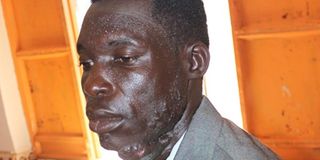How a pimple changed Lakane’s face

Amos Lekane has developed keloids as a result of a pimple that attacked his chin. PHOTO BY ALICE ADIKINI
What you need to know:
- Amos Lakane developed a pimple on his face and pressed it hoping it would clear. He was wrong.
- Years later that pimple has developed into pus-dripping keloids that have made his face almost unrecognisable.
In 1999, Amos Lakane was a healthy man in his thirties when he developed a pimple on his chin like most people in that age bracket normally do. But unlike the usual pimples that come and go leaving a simple scar, his was soon to change his life forever.
Lakane 42, a resident of Bardege in Gulu municipality, said when the pimple ripened he pressed it like is the usual practice but it never healed. Instead he started developing a boil which began producing pus and becoming painful in 2001.
A visit to Gulu Region Referral Hospital to seek medical advice got him painkillers and some antibiotics to mitigate the pain and dry the boil. This remedy did not help Lakane as the swelling increased and the pain intensified until it grew into keloids dripping with bloody pus.
“When neither the swelling nor the pain was reducing, I visited St Mary’s Hospital, Lacor in hope of a cure in vain,” he said.
Despair
It is several years later and Lakane is yet to find a cure for the keloids that continue to produce a bloody discharge.
His situation is worsened by unavailability of medicine in government health units. He spends Shs10,000 or more every week to purchase medicine in pharmacies and private health units. This lifestyle has cost him a lot, including selling his household property.
“In Lacor I pay for my medication because it is a private hospital. And in Gulu Regional Referral Hospital I can only get painkillers,” he says.
Looming danger
Lakane’s worry is that the keloids may turn cancerous if he does not get a cure since the painkillers and antibiotics he takes do not seem to help anymore.
He said he sought surgery from the two hospitals, Gulu regional referral and St Mary’s Lacor, in a bid to save his situation but was told that the affected area is near the throat and operating it may put his life in danger.
“I was advised to seek further medical attention from Mulago hospital or Kampala International Hospital where they can administer plastic surgery but my income now is Shs120,000 per month and I am the sole breadwinner for my family,” Lakane said.
Medical expert take on keloids
About keloids. The head of skin and STI clinic at Gulu Regional Referral Hospital, Dr Hope Kusasira, says keloids are thick swellings on a person’s body as a result of scars attained from injuries such as ear piercing, nose pricking, shavings and cuts, among others.
Treatment. He says there is no specific drug that can treat keloids but the condition can improve over the time.
Management. But the doctor says when the keloid is in its early stages it can be treated with silicone gel cream smeared on it once a day and left to dry. This process has to be continued for two months to achieve the best result.
Option. Another method of treating keloids is through exerting pressure on it. Here, a person has to wrap the affected area with a bandage tightly. And in the case of ears, one has to press it with clip-ons to reduce its size.
“It may take long to achieve the results but everything needs patience and persistence,” Dr Kusasira said.
When all the above fail, the doctor says, the affected person needs to be injected with triamcinolone.
“But in Lakane’s condition, all the above prescriptions may not work. All he needs is plastic surgery that can cost him Shs1.5 million,” Dr Kusasira asserts. “Once the plastic surgery is administered with methylprednisolone there will not be any other occurrence.”
Compiled by Darren A. Kyeyune




